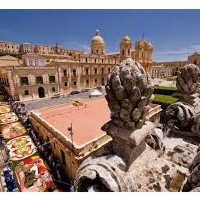
dal 1996 in continua innovazione tecnologica!
Sfrutta tecnologie avanzate per avere un sito web ottimizzato al 100%

Sicilian Baroque
The Sicilian Baroque fully matured only after the flowering of reconstruction followed the devastating earthquake that hit the Val di Noto in 1693. Before that date the Baroque style had struggled to establish itself in the island affected by the indigenous architectural tradition medievale late Renaissance and classical architecture has only recently established itself in the island. In the second half of the seventeenth century, however, the direct or indirect knowledge of the great architects of Baroque Rome had already experience fully mature Baroque. Following the 1693 earthquake, local architects (many of them trained in Rome) and the designers and artists from elsewhere, they found an abundance of opportunities to create a sophisticated Baroque style popular at the same time and cultured, strongly characterized rooted in the territory. In the penultimate decade of the eighteenth century style then ended up being replaced by new fads that brought the neo-classicism.
The era of Baroque Sicily, with its richly decorated style, perfectly reflected the social history of the island, and came to symbolize the nobility of his swan song, leaving a mark on the island of architectural identity.
The city streets are interspersed with scenic squares and imposing staircases and terraces that connect different levels. The reconstruction unit produced a coherent urban fabric and rich architectural examples. The soft local stone was used, the golden-colored and pink, richly carved. The reconstruction was unified under the leadership of the Duke of Camastra, which was known to the Spanish viceroy.
Unlike what usually happens in the Baroque buildings in the provinces of Southern Italy, especially as in Lecce and in Sicily, Catania, architects who work do not point to note all the ornaments, which are always well-controlled, with no imbalances compared to architectures in which they are inserted. In addition, the architects working in Noto, Rosario Gagliardi, Vincenzo Sinatra and Paul Labisi, engaged in the creation of elaborate architecture, with the use of concave sides (as in the Carmelite church or in that of San Carlo Borromeo in the Course) convex (like the church of San Domenico) or even curved, as in the bell tower of the seminary. The baroque city of Noto pervades the whole: the baroque are not isolated within an urban context characterized by different styles, but are linked together to create what has been called the "perfect Baroque city."
In this regard Ugo Ojetti argued: "Known to the early eighteenth century is one of our cities fate of a sudden, it seems from the fact of one will, precise image of the taste of an era. A visit, palaces, churches, convents, theater seems to be a unique monument, all built in the same yellow tuff, nin same baroque, as well Fichera says, flamboyant, with a grandeur and majesty without pausing without avarice. " Noto commitment of architects to create large sets, with a view baroque fully conscious and not provincial, he saw the image as well as a master Michelangelo Antonioni, who in a scene from L'Avventura, shot in Noto, is to tell the protagonist, played by Gabriele Ferzetti, intent to see the city from the terrace of the tower of the church of San Carlo al Corso: "What a fantasy, that movement. They were concerned EFFETI of scenery. What extraordinary freedom! "
